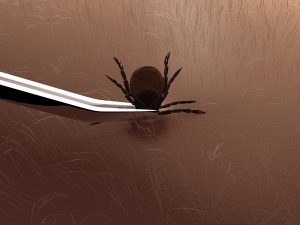By Jamell Andrews
With the warm weather and coming summer vacation, children will be spending more time outdoors. The warmer weather at this time of year also means that that tick season is in full swing. A tick bite can put your child at risk for different diseases, with Lyme disease being especially concerning. According to the Centers for Disease Control and Prevention (CDC), approximately 300,000 people are diagnosed with Lyme disease in the United States yearly.
While contact with ticks is less common in urban settings, living in a rural area or engaging in activities like walks in the woods or going to summer camp makes contact with ticks a lot more likely for your children. By taking the following simple precautions, you can help protect your children from tick bites and lower their risk of tick-borne diseases:
- Keep skin covered. If your child is going to be playing in areas that are more likely to be home to ticks, such as in wooded areas or areas with tall grass, keep their skin covered by dressing them in long sleeves and long pants. Tucking their pant legs into their socks is also recommended. Opt for lighter fabrics to help keep them cool and protected on hot days. A hat is also a good idea.
- Use repellents that contain DEET. Repellant sprays that contain 20 to 30 percent of DEET on exposed skin and clothing can provide several hours of protection from ticks and other insects. Always follow the directions on the packaging. Avoid spraying the eyes, mouth, and hands.
- Tick-repellant clothing. There are several brands of tick-repellant clothing on the market. You can also purchase tick sprays that can be used to protect clothing for several washes. These options repel and kill ticks on clothing, footwear, and even sleeping bags and other items your child may use during summer vacation.
- Checking for ticks. Check your child for ticks when they come indoors after playing outdoors. Check the hair, behind the ears, and in skin folds and creases, including between the toes and in the bellybutton. You can also get your child into the habit of checking themselves for ticks and other bugs. Also be sure to check clothing, bags and any other items your children bring indoors after being in tick-infested areas.
- Bathing with soap. Since ticks are tiny and difficult to see, it’s important that your child shower or bathe immediately after being outside even if you didn’t find anything on your initial inspection. Take this time to re-check your child’s hair and body for ticks.
- Dry clothes on high. Throwing clothes into the dryer for 10 minutes on a high-heat setting will kill any ticks that may be on the clothing. If in need of washing, wash using hot water. Delicates that can’t be exposed to high heat should be tumble dried on low for 90 minutes to kill ticks.
If You Find a Tick
If you find a live tick that is not attached, do not crush it with your hands. Instead, kill it by submersing it in alcohol. Place the dead tick in a sealed bag or container and throw it out. Wash your hands thoroughly.
To remove a tick that is attached to the skin:
- Use pointy tweezers to grasp the tick as close to the skin’s surface as you can
- Pull upward and keep your hand steady with even pressure to avoid breaking apart the tick if possible
- Submerse the tick in alcohol to kill it and then place it in a sealed bag or container before throwing it out. Wash your hands thoroughly
- Wash the tweezers
If your child develops a rash or fever within a few weeks of the tick bite, take them to the doctor and be sure to let the doctor know about the recent tick bite.
